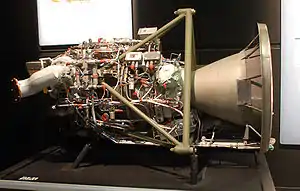R-4D
The R-4D is a small hypergolic rocket engine, originally designed by Marquardt Corporation for use as a reaction control thruster on vehicles of the Apollo moon program. Today, Aerojet Rocketdyne manufactures and markets modern versions of the R-4D.[1]
 An RCS quad containing four R-4D thrusters, as used on the Apollo Service Module | |
| Country of origin | United States |
|---|---|
| Manufacturer | Kaiser Marquardt Aerojet Rocketdyne |
| Application | Reaction control system |
| Liquid-fuel engine | |
| Propellant | NTO / MMH |
| Cycle | Pressure-fed |
| Performance | |
| Thrust (vac.) | 490 N (110 lbf) |
| Thrust-to-weight ratio | 13.74 |
| Chamber pressure | 6.93 bars (100.5 psi) |
| Isp (vac.) | 312 s |
| Used in | |
| Orion (spacecraft) H-II Transfer Vehicle Space Shuttle Apollo (spacecraft) Cassini (spacecraft) | |
History
Developed as an attitude control thruster for the Apollo Command/Service Module and Lunar Module in the 1960s, each unit for the modules employed four quadruple clusters (pods). It was first flown on AS-201 in February 1966. Approximately 800 were produced during the Apollo program.
Sixteen R-4Ds were mounted on the exterior of each lunar module in four quadruple clusters and sixteen on each service module. Because both the lunar module and service module were jettisoned during the Apollo missions, no flown examples, besides the set on the Apollo 10 lunar module lost in solar orbit, exist.[2]
Post-Apollo, modernized versions of the R-4D have been used in a variety of spacecraft, including the U.S. Navy's Leasat, Insat 1, Intelsat 6, Italsat, and BulgariaSat-1.[3] It has also been used on Japan's H-II Transfer Vehicle and the European Automated Transfer Vehicle, both of which deliver cargo to the International Space Station.[4]
Design
The R-4D is a fuel-film cooled engine. Some of the fuel is injected longitudinally down the combustion chamber, where it forms a cooling film.[5] The thruster's design has changed several times since its introduction. The original R-4D's combustion chamber was formed from an alloy of molybdenum, coated in a layer of disilicide.[2] Later versions switched to a niobium alloy, for its greater ductility. Beginning with the R-4D-14, the design was changed again to use an iridium-lined rhenium combustion chamber, which provided greater resistance to high-temperature oxidization and promoted mixing of partially reacted gasses.[5]
The R-4D requires no igniter as it uses hypergolic fuel.
It is rated for up to one hour of continuous thrust, 40,000 seconds total, and 20,000 individual firings.[5][6]
References
- "Bipropellant Rocket Engines". Aerojet Rocketdyne. Retrieved 7 May 2014.
- David Meerman Scott (November 2013). "Marquardt R-4D Apollo spacecraft attitude control engine". Apollo Artifacts. Retrieved 5 February 2016.
- "BulgariaSat-1". spaceflight101. Retrieved 23 June 2017.
- Stechman, Carl; Harper, Steve (July 2010). "Performance Improvements in Small Earth Storable Rocket Engines". 46th AIAA/ASME/SAE/ASEE Joint Propulsion Conference. AIAA. "Derivates of this engine are still used today on satellites and spacecraft including the European autonomous transfer vehicle (ATV) and the Japanese H-2 transfer vehicle (HTV) propulsion systems and the future Orion service module.
- Stechman, Carl; Harper, Steve (2010). "Performance Improvements in Small Earth Storable Rocket Engines- An Era of Approaching the Theoretical". The American Institute of Aeronautics and Astronautics. doi:10.2514/6.2010-6884. Cite journal requires
|journal=(help) - "R-4D". Astronautix. Retrieved 5 February 2016.
